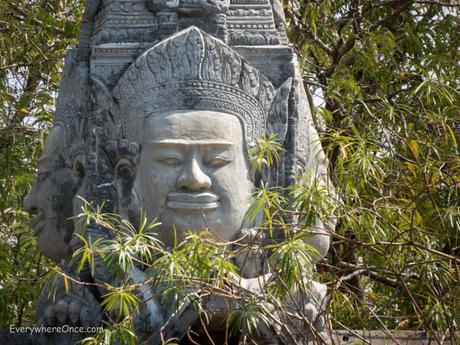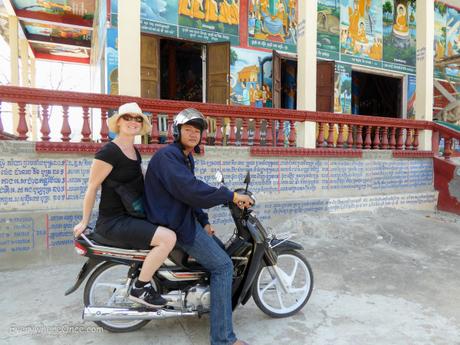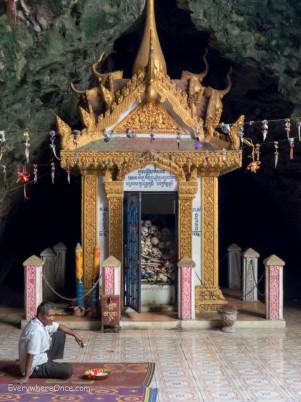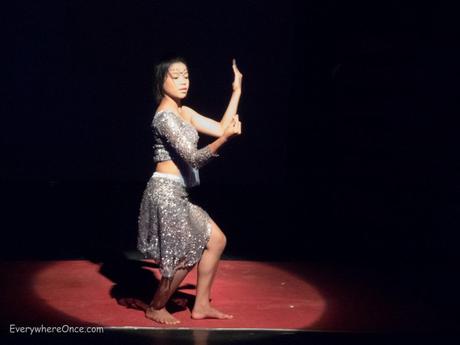
When we arrive at a new destination, it’s not uncommon for us to quickly, easily step into rhythm with the place. But sometimes, we get off on the wrong foot. Which is exactly what happened in Battambang in western Cambodia.
Battambang was a late addition to the itinerary. We rolled into town tired and sweaty after a seven-hour bus ride from Phnom Penh, only to be given a mosquito-infested room at our not-inexpensive hotel. Dinner at a recommended restaurant was dismally mediocre, while a walk around town showed that the preserved colonial architecture the city is hyped as having really isn’t all that picturesque.
Our less-than-stellar start in Battambang had us wondering why we even bothered to detour there on route from Phnom Penh to Siem Reap. If we hadn’t already booked a four-night stay, we might have hastily left town…and that would have been a shame. In Battambang, we ended up having some of our most memorable experiences in Southeast Asia so far.
Off Roading in a Tuk Tuk

“It’s going to be bumpy,” our tuk tuk driver warned us as we pulled away from Wat Banan, a twelfth-century temple, mostly in ruins, outside Battambang. He wasn’t exaggerating. To reach our next sightseeing destination, the shortest route was a little-used dirt tract road. Soon the tuk tuk was bucking like a bronco at a rodeo, our driver revving the motorbike’s engine and working hard to navigate the bumpy terrain.
Clouds of dust billowed around the tuk tuk as we traveled along a remote stretch of Cambodian countryside, bouncing around in the back of the tuk tuk as surprisingly comfortable seats cushioned our thrashing bodies. There was hardly any other traffic on the road, except for a lone rider on a motorbike and a young boy driving cattle. We drove past fields and rice paddies, chilies harvested and drying in the sun, the occasional wooden house and waving kids.
Forty-five minutes later the bouncing came to an end when we saw the gilded spires of a Buddhist temple perched atop Phnom Sampeu (Boat Mountain) gleaming in the sun. Getting there was indeed half the fun.
Our First Motorbike Ride

I’m a rule follower, barely a risk taker, and I almost never do spontaneous things. And yet, spur-of-the-moment, I jumped on the back of a motorbike, without a helmet and wondering what the heck I was supposed to grab onto.
I wanted to clutch the guy driving the bike, but hey, we had just met and it seemed a little forward. I hedged my bets, putting one hand on his shoulder and the other gripping the bar behind the seat. I barely had time to settle in before the bike lurched forward, and my new friend and I were off like a shot.
I thought we would spend four and a half months in Southeast Asia without ever riding a motorbike. It’s not exactly the safest way to get around. Helmets are a rarity, and traffic laws are more like loose guidelines. Repeatedly seeing tourists sporting souvenir scrapes and scabs from motorbike mishaps only reinforced my aversion. Even being on the back of one wasn’t a risk I intended to take. But tired feet changed my tune. We had climbed several hundred steps at Wat Banan, and by the time we got to Phnom Sampeau the intense midday heat dissuaded us from making the long, steep trek on our own.


If we were going to see a historic cave and the temples and pagodas even further up the mountain, we needed some mechanical assistance. So I threw caution to the wind and held on tight, precariously perched on the motorbike, feeling like I was going to slide off the back as it zipped up the mountain. I won’t be on another motorbike anytime soon, particularly without a helmet, but seeing the cave and temple was worth the calculated risk.
Like the Killing Fields in Phnom Penh, the cave is now a memorial to the people who died there during the Khmer Rouge’s brutal reign in the 1970s. Like so many other places across Cambodia, beautiful Phnom Sampeu was turned into a site of mass executions. Today a golden Buddha statue reclines in the cave, illuminated by sunlight filtering through a hole in the ceiling. This natural skylight once served an ominous purpose. Victims were bludgeoned to death and their bodies tossed through the opening into the cave, where a collection of skulls and bones is a stark reminder of the tragedies that happened here.
Wowed (and White-Knuckled) at the Circus

A kaleidoscope of daring feats unfolded in front of us and other spectators packing the bleachers beneath a colorfully striped circus tent. The impressively skilled and poised performers onstage were students at Phare Ponleu Selpak, an organization that provides arts vocational training—including music, painting and drawing, and circus performing—to underprivileged children and young adults.
Phare Ponleu Selpak was founded in 1994 by several Cambodians, who forged the idea while living in a refugee camp, as a way to help disadvantaged kids get ahead and also to revitalize and promote Khmer culture after the devastation wrought by the Khmer Rouge. A cultural hub, Battambang was hit hard during Pol Pot’s regime, which targeted for execution artists, musicians, writers, and filmmakers.

Some of Phare Ponleu Selpak’s students will go on to join the organization’s professional circus venue in Siem Reap. The night we saw them perform, they put on a top-notch show telling the tale of a man returning from war, broken in mind and body. His children rally around him, helping him to overcome the haunting and tragic experience and return to the land of the living. The performance blended a touching story with slapstick comedy and challenging acrobatic stunts that truly left us in awe.

